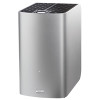Western Digital My Book Thunderbolt Duo User Manual - Page 14
Managing and Customizing Your My Book Thunderbolt Duo Device, Checking Device Health - price
 |
View all Western Digital My Book Thunderbolt Duo manuals
Add to My Manuals
Save this manual to your list of manuals |
Page 14 highlights
MY BOOK THUNDERBOLT DUO USER MANUAL 13 Managing and Customizing Your My Book Thunderbolt Duo Device This chapter includes the following topics: Checking Device Health Managing the RAID Configuration Erasing the Device Drives Registering the Device Restoring the WD Software and Disk Image Safely Dismounting the Device Drives The WD Drive Utilities software (see Figure 3 on page 9) makes it easy for you to manage and customize your storage device for the best possible performance: • Diagnostics-Run diagnostics and status checks to make sure your device drives are working properly. • RAID Management-Check the operational status or change the device drive configuration. • Drive Erase-Erase all of the data on the drives. • Registration-Register your device to receive free technical support during the warranty period and find out about software updates, product enhancements, and price discount opportunities. On the WD Drive Utilities screen: IF you want to . . . Run drive diagnostics and status checks, Check the RAID status or change the configuration of the device drives, Erase the drives so you can retrieve the space and start over, Register the device to receive free technical support during the warranty period and keep up-to-date on the latest WD products, THEN click . . . Diagnostics RAID Management Drive Erase Registration AND see . . . "Checking Device Health" in the next section. "Managing the RAID Configuration" on page 12 "Erasing the Device Drives" on page 16. "Registering the Device" on page 18. Checking Device Health The WD Drive Utilities software provides three diagnostic tools to help make sure that your device is performing well. Run the following tests if you are concerned that your device is not operating properly: • S.M.A.R.T. Status Check S.M.A.R.T. is a failure-prediction function that continuously monitors key internal performance attributes of the device drives. A detected increase in drive temperature, noise, or read/write errors, for example, can provide an indication that the drive is approaching a serious failure condition. With advanced warning, you could take precautionary measures, like moving your data to another device, before a failure occurs. The result of a S.M.A.R.T. status check is a pass or fail evaluation of the drives' condition. MANAGING AND CUSTOMIZING YOUR MY BOOK THUNDERBOLT DUO DEVICE - 10















